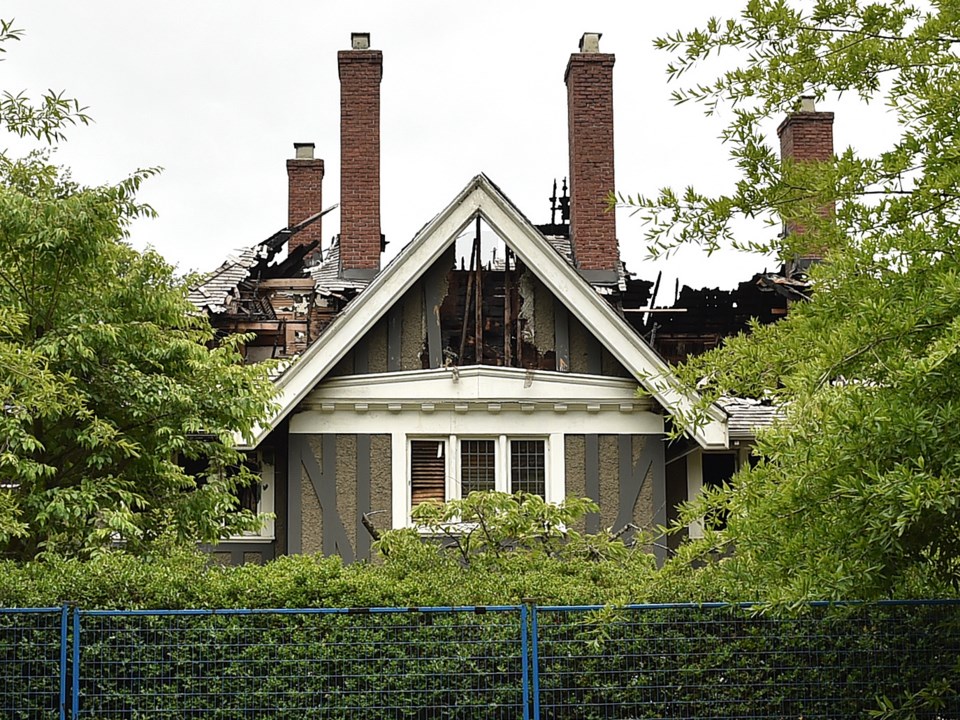The City of Vancouver has filed a petition with the B.C. Supreme Court seeking to declare the owners of a fire-damaged heritage home at 3737 Angus Dr. in violation of the Heritage Property Standards of Maintenance bylaw.
The city wants a mandatory order forcing the owners to comply with the requirements of the bylaw and it's also asking for an order that would force the owners to pay for the costs associated with the proceedings.
The homeowners are Miao Fei Pan and Wen Huan Yang.
The house was purchased for $10.7 million on Oct. 5, 2012. It was assessed at $14.2 million as of July 1, 2017.
A fire, which investigators concluded was caused by arson, significantly damaged the roof and walls of the Angus Drive home in October 2017. It was vacant and unfurnished at the time, the report from the fire department stated.
A protective covering wasn’t put on the house after the incident to protect it from the elements despite orders from the city to do so.
The petition through the B.C. Supreme Court is the latest move by the city to address concerns about the state of the 1910 heritage building, which is in the First Shaughnessy Heritage Conservation Area — Vancouver’s first-ever conservation area. The house was designed by architects Samuel Maclure and Cecil Fox, and built by contractors Coffin and McLennan.
The Heritage Property Standards of Maintenance bylaw was adopted in 2015.
In June, the city prosecutor’s office also approved charges under the Heritage Property Standards of Maintenance against the owners — charges which have yet to be proven in court. The information was sworn at Robson Square Provincial Court June 20.
Count one in that case alleges that between Feb. 17 and May 14, 2018, the owners failed to repair and maintain all buildings, structures and features at the property “to reasonably prevent or retard damage caused by weather, wind, sun, moisture, infestation, rot, decay or similar causes...”
Count two alleges that between Feb. 17 and May 14, 2018, the owners failed to comply with an order dated Nov. 1, 2017, and “extensions thereto,” directing that the building at 3737 Angus Dr. “be maintained so as to reasonably prevent further damage caused by weather, infestation, rot, or similar decay, on or before February 16, 2016...”
A conviction could result in a court-imposed fine of up to $10,000,
Read more about that case HERE.
The main difference between the petition and the charges that had previously been laid is that the petition to the B.C. Supreme Court is considered a civil matter while the charges are a prosecution.
In addition to seeking a declaration that the owners are in violation of the bylaw, the city, through the petition to the B.C. Supreme Court, wants an order that:
- requires the owners to hire registered professionals and submit a complete heritage alteration permit application to repair the building within 15 days of the date of the order;
- requires the owners to make complete applications for building, plumbing, trades and electrical permits, as may be required, within 15 days after the issuance of the heritage alteration permit;
- requires the owners to retain a contractor within 15 days after the issuance of the application permits; and
- requires the owners to complete the restoration work in accordance with the approved plans within three months after the contractor is retained.
In terms of timeline for the B.C. Supreme Court matter, the steps in the process are:
- The petition and affidavits are served personally on the defendant owners of the property;
- The defendants must file and serve their response and supporting affidavits within 21 days, but this period can be extended either by agreement or by order of the court; and
- The city then can reply to the response if there is anything in the response that hasn’t been addressed in the petition or supporting affidavits.
A statement of significance produced by heritage consultant Elana Zysblat said that the arts-and-crafts-style home, known as the Frank W Rounsefell Residence, is important for "how it illustrates the establishment of Shaughnessy Heights as the exclusive Vancouver neighbourhood developed by the Canadian Pacific Railway in 1907 between West 16th & King Edward Avenues, Arbutus and Oak Streets."
Rounsefell was a wealthy businessman and community leader in the late 19th and early 20th century. The home is also associated with Donald C. Cromie, who was publisher and owner of the Vancouver Sun newspaper between 1942 and 1964. Cromie owned and lived in the house from 1955 to 1967.
Zysblat's report notes that character-defining elements of the house include: its continuous use as a single-family residence since 1911, its prominent location on Angus Drive in First Shaughnessy, its rectangular, horizontal form in the arts-and-crafts style, and its large garden.
@naoibh



